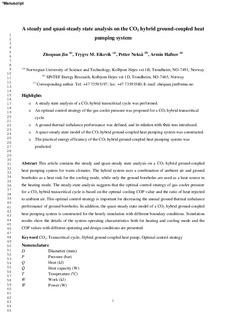A steady and quasi-steady state analysis on the CO2 hybrid ground-coupled heat pumping system
Journal article, Peer reviewed
Accepted version
Permanent lenke
http://hdl.handle.net/11250/2487197Utgivelsesdato
2017Metadata
Vis full innførselSamlinger
- Publikasjoner fra CRIStin - SINTEF Energi [1640]
- SINTEF Energi [1764]
Originalversjon
International journal of refrigeration. 2017, 76 29-41. 10.1016/j.ijrefrig.2017.01.029Sammendrag
This article contains the steady and quasi-steady state analysis on a CO2 hybrid ground-coupled heat pumping system for warm climates. The hybrid system uses a combination of ambient air and ground boreholes as a heat sink for the cooling mode, while only the ground boreholes are used as a heat source in the heating mode. The steady state analysis suggests that the optimal control strategy of gas cooler pressure for a CO2 hybrid transcritical cycle is based on the optimal cooling COP value and the ratio of heat rejected to ambient air. This optimal control strategy is important for decreasing the annual ground thermal imbalance performance of ground boreholes. In addition, the quasi-steady state model of a CO2 hybrid ground-coupled heat pumping system is constructed for the hourly simulation with different boundary conditions. Simulation results show the details of the system operating characteristics both for heating and cooling mode and the COP values with different operating and design conditions are presented.

